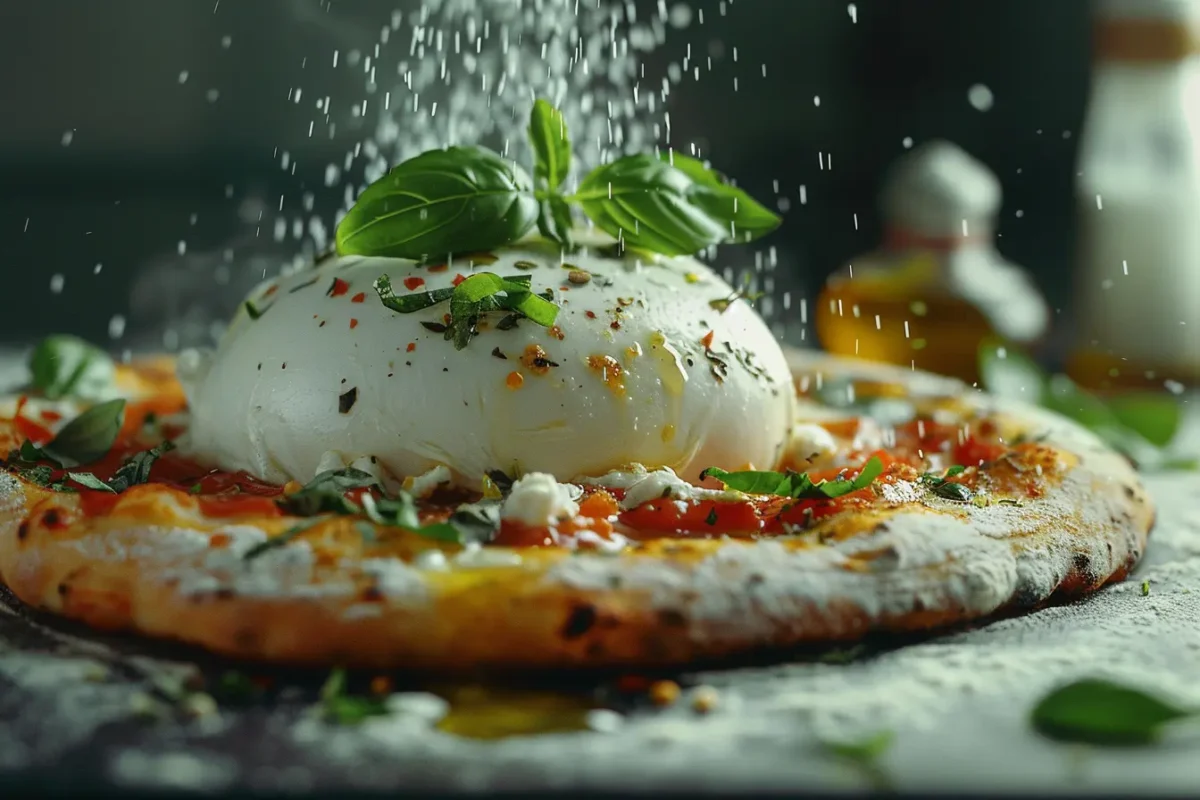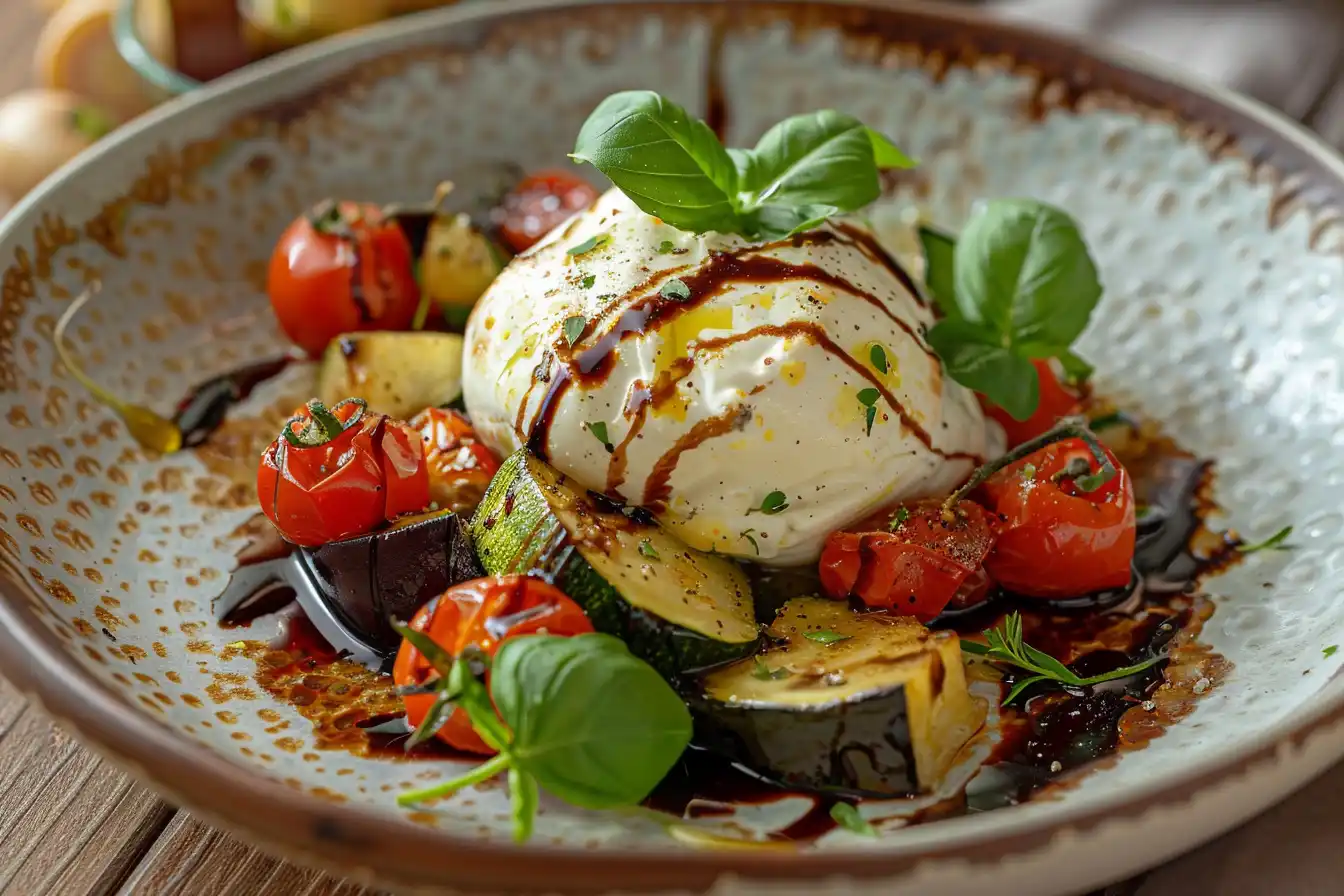Does burrata melt? Burrata is loved for its creamy, indulgent texture, but if you’ve ever tried using it in a hot dish, you might have noticed something unusual. Unlike mozzarella or cheddar, burrata doesn’t melt the way you’d expect—instead, it softens and oozes, creating a luscious, velvety texture.
So, does burrata melt completely, or does it just soften? What makes burrata behave this way? And how can you use it effectively in warm dishes without ruining its signature creaminess? In this article, you’ll discover why burrata reacts differently to heat, how to incorporate it into your cooking, and expert tips to make the most of its rich flavor.
Jump to:
Does Burrata Melt? Understanding Its Texture
What is Burrata?
Burrata is no ordinary cheese—it’s an experience. Made from a pouch of mozzarella filled with stracciatella (shredded mozzarella soaked in cream), burrata delivers a buttery, creamy burst of flavor in every bite. The name “burrata” stems from the Italian word burro, meaning butter, a nod to its rich interior.
Hailing from Puglia, Italy, burrata was initially created as a way to minimize waste by using leftover mozzarella curds. This innovation led to a cheese that’s now synonymous with elegance and indulgence. But does burrata melt the same way as other cheeses? Unlike aged cheeses, burrata is best enjoyed fresh, where its creamy center can be fully appreciated, rather than melting into a gooey consistency like mozzarella or cheddar.
Burrata’s Unique Properties
The magic of burrata lies in its contrast of textures. Its mozzarella shell is soft and pliable, while the inner cream is luscious and spreadable. This high moisture content not only contributes to its velvety texture but also defines how it reacts to heat.
Unlike firmer cheeses like cheddar or gouda, burrata doesn’t melt in the traditional sense. Instead, it softens and oozes, making it ideal for finishing dishes rather than as a melting ingredient. This unique characteristic is why burrata often crowns salads, pizzas, and pasta rather than being cooked into them.
Does Burrata Melt Well?
The Science Behind Burrata’s Texture
When pondering “Does burrata melt” well, the answer isn’t a simple yes or no. Unlike firmer cheeses like mozzarella or cheddar, burrata doesn’t melt in the traditional sense. Its unique structure—a mozzarella shell encasing a creamy stracciatella core—means it softens and oozes rather than fully liquefying.
So, does burrata melt completely when heated? Not quite. When exposed to heat, the outer layer of burrata can become warm and pliable, while the creamy interior retains its luscious texture. This makes burrata ideal for use as a finishing touch on hot dishes. For example, placing it on a freshly baked pizza or a hot plate of pasta allows it to gently soften, adding a luxurious creaminess to the dish without losing its integrity.
While burrata is best enjoyed fresh, it pairs beautifully with a variety of ingredients that enhance its creamy texture. If you’re looking for creative ways to serve burrata, check out our guide on Italian Burrata Pairings: Delicious Ideas and Recipes for mouthwatering combinations with pasta, salads, and more
Creative Ways to Serve Burrata
Given its behavior under heat, burrata is best utilized as a topping rather than a cooking ingredient. Here are a few ideas:
- Pizza Finisher: Add burrata to a pizza right after it comes out of the oven. The heat will gently soften the cheese, creating a delightful contrast with the crispy crust.
- Pasta Topper: Place burrata on a hot plate of pasta, such as spaghetti or rigatoni, for a creamy, indulgent upgrade.
- Baked Vegetables: Add burrata to roasted zucchini or eggplant for a combination of earthy and rich flavors.
How to Use Burrata Effectively in Recipes
Pairing it with Room-Temperature Ingredients
Burrata’s delicate flavor and texture shine brightest when served fresh and at room temperature. Pairing it with ingredients like ripe tomatoes, fresh basil, and a drizzle of olive oil is a classic way to enjoy its creamy richness. Room-temperature ingredients ensure that burrata’s subtle creaminess isn’t overshadowed by overly cold or hot components.
For an easy yet elegant dish, try serving burrata with a side of crostini, arugula, and balsamic glaze. These elements enhance burrata’s flavor profile while maintaining its integrity.
Looking for the best ways to enjoy burrata? Check out our guide on Italian Burrata Pairings: Delicious Ideas and Recipes to discover perfect flavor combinations and creative serving suggestions!
Creative Recipes for Every Occasion
The versatility of burrata allows it to adapt to a wide variety of recipes. Here are some ideas:
- Bruschetta with Burrata: Spread burrata over toasted bread, then top with roasted cherry tomatoes and basil for a simple yet gourmet appetizer.
- Gourmet Salads: Toss burrata into a salad with roasted butternut squash and toasted pine nuts for a hearty yet refreshing dish.
- Flatbreads and Pizzas: Incorporate burrata as a creamy addition to flatbreads with caramelized onions and arugula.

The Science Behind Burrata’s Texture
How is it Made
To truly understand does burrata melt well, it helps to look at how this luxurious cheese is crafted. Burrata begins with mozzarella, which is stretched and shaped into a pouch. Inside this pouch is stracciatella, a mixture of shredded mozzarella and cream. This inner core is what gives burrata its rich, velvety texture.
Unlike other cheeses that are designed to melt uniformly, burrata’s high moisture content means it reacts differently to heat. The cream-filled center softens but doesn’t liquefy like a firmer cheese would. This unique structure explains why burrata is best used as a topping or finishing touch rather than a primary ingredient in cooked dishes.
Why Doesn’t Burrata Melt Like Mozzarella?
Compared to mozzarella or cheddar, burrata’s melting properties are unique. While mozzarella stretches and melts due to its protein structure, burrata’s creamy interior has a much lower melting point. The result? Burrata becomes soft and runny but never fully melts into a cohesive layer.
This quality makes burrata ideal for dishes that require a creamy texture without complete melting. For instance, topping a hot pizza or warm flatbread with burrata creates a delightful contrast between the crust and the soft cheese.
Tips for Handling and Serving Burrata
Storage and Freshness Guidelines
Burrata is best enjoyed fresh, ideally within a day or two of purchase. Its delicate structure and high moisture content mean it doesn’t store well for long periods. To maintain its texture, keep burrata in its original liquid or store it in a sealed container filled with water in the refrigerator.
Before serving, always let burrata sit at room temperature for 30 minutes. This step enhances its flavor and ensures the creamy interior is at its most luscious.
Serving Suggestions to Enhance Flavor
When serving burrata, simplicity is key. Drizzle it with olive oil and sprinkle with flaky sea salt to let its natural creaminess shine. Pair it with complementary ingredients like roasted vegetables, fresh fruits, or cured meats for a well-balanced dish.
For a warm dish, place burrata on roasted zucchini or eggplant right before serving. The residual heat will gently soften the cheese, creating a perfect harmony of textures.
Exploring Creative Burrata Pairings
Sweet and Savory Pairings with Burrata
Burrata’s mild, creamy flavor makes it perfect for pairing with both sweet and savory ingredients. For those curious about does burrata melt well, its softening qualities make it an excellent choice for dishes where creaminess is key.
On the sweet side, pair burrata with fresh fruits like figs, peaches, or strawberries. A drizzle of honey or balsamic glaze elevates the flavors, creating a delightful contrast with the cheese’s buttery texture.
For savory pairings, try roasted vegetables, prosciutto, or grilled peaches. Burrata’s richness complements these ingredients without overpowering them, making it a versatile addition to any dish.
Want to try burrata in a delicious, cheesy meal? Check out our Cheesy Chicken Wraps Recipe: Easy, Delicious, and Customizable for a flavorful dish that pairs perfectly with creamy cheeses like burrata!
Transforming Classic Dishes with Burrata
Burrata has the power to transform even the simplest dishes into gourmet creations. Add it to a classic Margherita pizza just before serving, allowing the residual heat to gently soften the cheese. Or, top a warm bowl of tomato soup with burrata for a comforting, creamy twist. Explore the nuanced differences between these beloved Italian cheeses by reading “Mozzarella vs Burrata: Key Differences ” and discovering creative recipes in “Burrata Cheese: The Ultimate Guide to Recipes and Tips”.
FAQs
Why Doesn’t Burrata Melt Completely?
The question does burrata melt well often comes up for those new to this creamy cheese. The answer lies in its composition. Burrata is made with a delicate mozzarella shell that can soften under heat, but its creamy interior, made from stracciatella, has a high moisture content and a low melting point. Instead of fully melting, the interior oozes into a rich, velvety texture.
This unique behavior is why burrata is better used as a topping for warm dishes rather than as an ingredient to be baked or cooked directly.
Can Burrata Be Used as a Substitute for Mozzarella?
While burrata and mozzarella share similarities, they are not interchangeable in all recipes. Mozzarella’s firmer texture and elastic melt make it ideal for pizzas and baked dishes. Burrata, on the other hand, excels as a finishing touch on these same dishes, adding creaminess and an indulgent flair.
What Are the Best Ways to Warm Burrata?
Although burrata shouldn’t be cooked, it can be gently warmed. For example, placing burrata on freshly roasted vegetables or warm pasta allows it to soften naturally from residual heat. Another method is to use it as a topping for soups just before serving, adding a luxurious creamy texture.
What Dishes Work Best with Burrata?
Burrata’s versatility makes it suitable for a range of dishes. From gourmet appetizers like bruschetta to hearty salads and even desserts with fruits and honey, burrata elevates every recipe. It also pairs beautifully with roasted vegetables, crusty bread, and balsamic glaze.
Conclusion
Burrata’s creamy texture and rich flavor make it a standout ingredient in Italian cuisine. While it doesn’t melt like mozzarella, its ability to soften and ooze adds a luxurious touch to dishes. Whether placed atop a hot pizza, served with roasted vegetables, or paired with fresh tomatoes and basil, burrata enhances any meal with its indulgent, buttery goodness.
“Rather than seeing burrata as a melting cheese, think of it as an experience—one that adds depth, creaminess, and sophistication to every bite.”
Final Thoughts
Understanding how burrata reacts to heat allows you to use it more effectively in your cooking. Instead of expecting it to stretch and melt, embrace its unique softening qualities to elevate everything from salads to pastas. By experimenting with different pairings and serving methods, you’ll unlock new ways to enjoy this Italian delicacy.
Call to Action
Now that we’ve explored “Does burrata melt?”, we’d love to hear from you!
👇 How do you enjoy burrata? Do you prefer it fresh, on pizza, or as a creamy topping for pasta?
Drop a comment below and share your favorite burrata dish! 🧀❤️🚀

